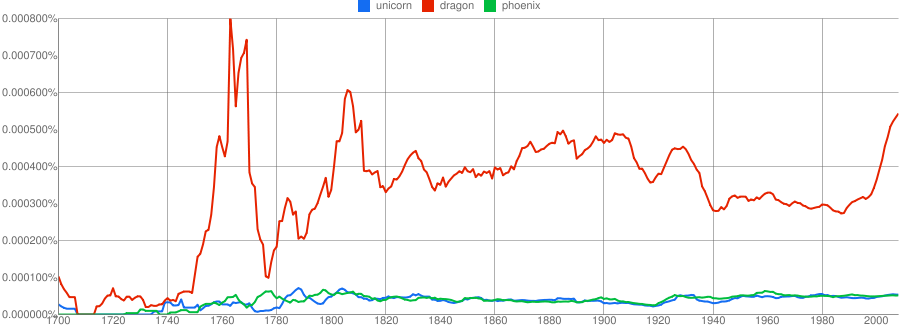Fun with Numbers
Google has a new toy, called Ngrams. Since they have digitized over a million books, and converted them (roughly) to searchable text, they have a huge database of word usage from before 1700 to 2008. Ngrams is a tool that charts the occurrence of words or sets of words in that database. Of course the charts are not entirely representative of word usage, since the database is full of text conversion errors and only covers a small percentage of the books published over the last three centuries.
So let’s chart our favorite word: bestiary.
There is an obvious upsurge in interest around 1882. Why? One possibility is the English “antiquaries”: English (mostly) idle gentlemen-scholars who wandered around “discovering” old things, like manuscripts and church carvings. There were quite a few of these antiquaries; they even had societies, associations and clubs, held meetings, and published journals. A member of the Society of Antiquaries (one of the most prestigious) could add the letters FSA (Fellow of the Society of Antiquaries) after his name. One such was George Claridge Druce (1860-1948); there are several articles by him in the Digital Text Library.
The word “bestiary” is also common in English fiction.
It really takes off after World War II, with another spike around 1990.
How about some of our favorite beasts? Charting “real” beasts doesn’t tell us much, so here is the chart for three of the most popular fabulous beasts: Unicorn, Dragon and Phoenix.
Surprisingly, the unicorn and phoenix have the same popularity, with the dragon far ahead of either. The unicorn doesn’t even improve significantly after the 1980s, when all the new-agey people started loving the beast. As for the bonnacon: as usual, the poor beasty gets no respect; if charted against the unicorn and/or dragon, his line doesn’t get above the axis. The bonnacon is sad.
Filed in Articles No Responses yet


